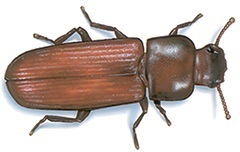
Characteristics
SIZE: One-eighth of an inch.
COLOR: Reddish-brown.
BEHAVIOR: The red and confused flour beetles are nearly identical in biology and habits except that the red flour beetle can fly and the confused flour beetle does not. Red and confused flour beetles are capable of breeding year-round in heated buildings. Either species, however, could be encountered anywhere. Female beetles deposit eggs in twos or threes within the food material until eventually 300 to 400 eggs are laid. The larvae hatch from these eggs in about nine days and go through five molts. The life cycle from egg to adult may take seven weeks to three months depending on temperature and humidity conditions as well as quality of the food source. The development time for confused flour beetles takes longer than red flour beetles. The adult beetles may live up to three years or longer.
HABITATS
Flour beetles are scavengers in that they cannot attack whole grains and must rely on other insects such as rice weevils or lesser grain borers to damage the kernels first. These beetles are most common in processed grain products. They have chewing mouthparts so they can chew their way into packages. Their small and flattened bodies allow them to exploit small gaps in packaging to get into a package. Flour and other processed food products heavily infested by these beetles often develop a grayish tint. This graying also promotes the growth of mold, which further contaminates the food product. Additionally, secretions from the beetles may add a disagreeable odor to the food product.
TIPS FOR CONTROL
The control of any stored product pest involves many steps, primary of which is discovery of infested food items or other sources of infestation (e.g., food spillage accumulation). All dried food products need to be inspected for signs of infestation, including cereals, packaged dried foods (e.g., food bars and chocolate) and pet foods. Keep in mind that infested items may not always be stored in the kitchen. Products made of or containing vegetative materials may be stored in any room of a house. Infestations have also been traced to old rodent baits placed in attics, wall voids and similar out-of-the way locations. A pest control professional can be helpful in finding difficult infestation sources. Consider the following to prevent an infestation:
- Always inspect food packaging before you purchase the product. Look for intact packaging with no cuts, punctures or chewing marks. Packages with food debris on or around them should not be purchased. Discard infested foods in outdoor trash. Infested decorations (flowers, wreaths, etc.) should also be discarded.
- Freeze suspect foods at zero degrees Fahrenheit for six days. Clean cabinets and shelves where infested foods are stored by vacuuming and by using soap and water.
- Store all dried food goods, including dried pet foods and birdseed, in a glass or plastic container with a tight lid. If beetles are in that food product then the infestation may be contained and may not spread to other foods.
- Consider storing cereals and similar foods in the refrigerator to limit stored product pest problems.
- Consume older food products prior to newer purchases of the same food. Products purchased in larger quantities (e.g., from a wholesale food warehouse) are more likely to become an infestation source if these are stored for long periods of time – especially if they are not stored in containers with tight-fitting lids.


